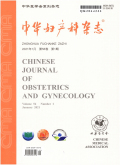腹腔镜与开腹子宫肌瘤剔除术后肌瘤残留、复发及妊娠结局的比较
Comparison of postoperative residue, recurrence and pregnancy outcome between laparoscopic and transabdominal myomectomy
摘要目的:比较子宫肌瘤患者腹腔镜与开腹子宫肌瘤剔除术的手术学特点、术后肌瘤残留、复发情况及妊娠结局。方法 回顾性分析2008年1月至12月在北京协和医院同期行腹腔镜或开腹子宫肌瘤剔除术461例患者的临床资料,腹腔镜313例、开腹148例,比较其一般情况、围手术期特点、术后残留、复发及妊娠结局。结果开腹患者剔除最大肌瘤直径(7.6±3.0) cm、剔除肌瘤数目(5.6±5.5)个、剔除肌瘤重量(308 ±364)g均高于腹腔镜患者[分别为(6.8±2.0) cm、(2.4±2.1)个、(140±109)g],分别比较,差异均有统计学意义(P<0.01)。与腹腔镜患者相比,开腹患者的手术时间长[分别为(74 ±35)、(89±32) min]、术中失血量增多[分别为(149±252)、(239±251)ml]、围手术期血红蛋白含量降低程度增大[分别为(15±12)、(22±14) g/L]、术后住院时间增加[分别为(4.4±1.3)、(6.4±1.6)d],分别比较,差异均有统计学意义(P<0.01)。然而,腹腔镜与开腹患者术后残留率(分别为2.6%、1.4%)、复发率(分别为11.1%、12.3%)、术后妊娠率(分别为49.2%、9/13)比较,差异均无统计学意义(P>0.05)。肌瘤数目是影响复发的主要因素(OR=2.805,95%CI为1.192 ~6.601,P=0.0180)。所有术后妊娠患者均未发生妊娠中子宫破裂。结论腹腔镜与开腹子宫肌瘤剔除术是有生育要求或要求保留子宫患者的有效、安全的治疗方式。大部分的子宫肌瘤手术可以通过腹腔镜完成。腹腔镜子宫肌瘤剔除术的术后残留率高于开腹术式,但术后短期复发率相近。多发肌瘤是复发的主要危险因素;肌瘤数目≥4个者腹腔镜子宫肌瘤剔除术后复发率增加。腹腔镜与开腹子宫肌瘤剔除术后妊娠率相当。
更多相关知识
abstractsObjectives To compare operative characteristics, postoperative residue, recurrence, and pregnancy outcome between laparoscopic myomectomy (LM) and transabdominal myomectomy (TAM),and investigate the favourable surgical approach in women with uterine myomas. Methods From Jan 2008 to Dec 2008, 313 women undergoing LM and 148 women undergoing TAM were studied retrospectively in Peking Union Medical College Hospital. The patients' general information, including the largest diameter,mean numbers and weights of excised myomas, peri-operative characteristics (operating time, blood loss,and hemoglobin decrease), and residue, recurrence of myoma, and pregnancy outcome were compared and analyzed. Results The largest diameter, mean numbers and mean weight of myomas removed were larger in TAM group [( 7.6 ± 3.0) cm, (5.6 ± 5.5 ), ( 308 ± 364) g, respectively]than those in LM group [(6.8±2.0) cm, (2.4 ±2.1), (140 ± 109) g, respectively; P<0.01]. While the extension of operating time [(89±32) versus (74 ±35) min], increased blood loss [(239 ±251 ) versus ( 149 ±252) ml]and hemoglobin decrease [(22 ± 14) versus ( 15 ± 12) g/L], and longer hospital stay [(6. 4 ± 1. 6)versus (4. 4 ± 1.3) d]were observed in TAM group when compared with those in LM group ( P <0. 01 ).However, the residue rate of LM and TAM was 2. 6% versus 1.4% respectively ( P = 0. 5130 ) ; the recurrence rate of LM and TAM was 11.1% versus 12. 3% (P > 0. 05 ) ; the pregnancy rate of LM and TAM was 49. 2% versus 9/13 separately, the difference was not statistically significant ( P = 0. 2330 ). The number of myomas removed was the significant risk factors associated with recurrence ( OR = 2. 805, 95%CI: 1. 192 -6. 601, P = 0. 0180). No uterine rapture occurred during pregnancy. Conclusions Both LM and TAM are effective surgical approaches for the patients with leiomyoma who desire to pregnancy, or to retain the integrity of their uteruses. Most of uterine myoma could be treated through laparoscopy. The residue rate of LM is higher than that of TAM. However, the short term recurrence rates of LM and TAM are similar. Multiple myomas is the risk factor associated with recurrence after myomectomy. The pregnancy rates are comparable between LM and TAM groups.
More相关知识
- 浏览162
- 被引265
- 下载1363


相似文献
- 中文期刊
- 外文期刊
- 学位论文
- 会议论文



 换一批
换一批 换一批
换一批



